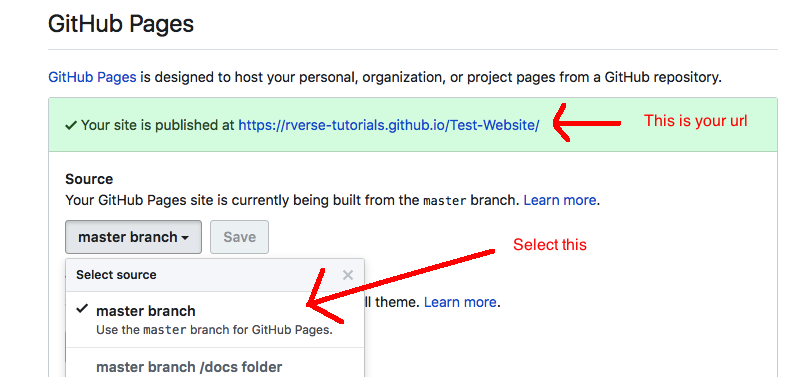This will show you how to make a very simple website with R Markdown and put that online via GitHub Pages. When you are ready to learn more go to the Links page for more tutorials.
Simple website template
Clone the RVerse-Tutorials-Website repository.
- Copy the URL.
- Open GitHub and click the “+” in top right for new repo. Select ‘Import repository’, then select import from URL and paste in the URL.
- Once it is imported (might take awhile), copy the URL for your new repository.
- Open RStudio. Click the blue cube with R in top right. Select New Project > Version Control > Git and paste in the URL.
Now you’ll have a copy of Test-Website on GitHub and a copy on your computer that is linked to your remote repository (on GitHub).
Build the website
- From RStudio, click ‘Build’ from upper right and then ‘Build Website’. Your website should open. You can select ‘View in browser’.
- You can also right click on ‘index.html’ from the files, and select ‘open in browser’.
Watch a video of this step
Overview
There are two required files for a website plus your content (your R Markdown files).
The first required file is _site.yml which is your configuration file.
The second required file is index.Rmd which is your landing page or page #1.
Your content is specified in additional R Markdown files. Not required, but your website is not very interesting without content.
_site.yml
The _site.yml specifies the basic info about your site and the navigation bar at top.
name: "my-website"
output_dir: "."
navbar:
title: "My Website"
left:
- text: "Home"
icon: fa-home
href: index.html
- text: "About"
icon: fa-bullhorn
href: about.html
menu:
- text: "Page A"
href: page_a.html
- text: "Page B"
href: page_b.html
output:
html_document:
theme: readable
toc_depth: 3
toc_float:
collapsed: false
index.Rmd
index.Rmd is just your landing page. You can have as little or as much content as you want here. When readers click on your site, they will see this page first.
A minimal index.Rmd would look like:
---
title: "My website"
---
Here is my website.
Content
You can now add as many Rmarkdown files as you want for your content. Each one will be processed into an html file. For example in Test Website, we have two files, about.Rmd and contact.Rmd. Your Rmd files should have the yaml at top and then your Rmarkdown content.
Here is a simple example.
---
title: Simple Rmd File
---
Here is a simple file.
about.Rmd is a fuller Rmd file with R code and figures.
If you want the file linked to in your top nav bar, then add it to _site.yml.
name: "my-website"
output_dir: "."
navbar:
title: "My Website"
left:
- text: "About"
href: about.html
- text: "Contact"
icon: fa-user-circle
href: contact.html
output:
html_document:
theme: readable
toc_depth: 3
toc_float:
collapsed: false
Make your website live
Watch a video of this step
Here is how to make your website live on GitHub.
First you need to add this as a repository on GitHub.
Open GitHub Desktop and select File > New Repository. Type ‘Test-Website’ (or if you renamed it, then whatever you renamed it to). Leave everything else blank (for now).
This adds your repository to GitHub Desktop. Now click ‘Publish’ in the top right corner. If ‘private’ is checked, uncheck that.
Next you need to open your repository on GitHub and set it up to serve a webpage.
- Go to your GitHub account.
- Click on the new Test-Website repository.
- Click on Settings.

- Scroll down to GitHub Pages and change source from ‘none’ to ‘master branch’.

- Wait a few minutes and then go to your new webpage. The link will appear just above where your changed the source.
NWFSC Math Bio Program

